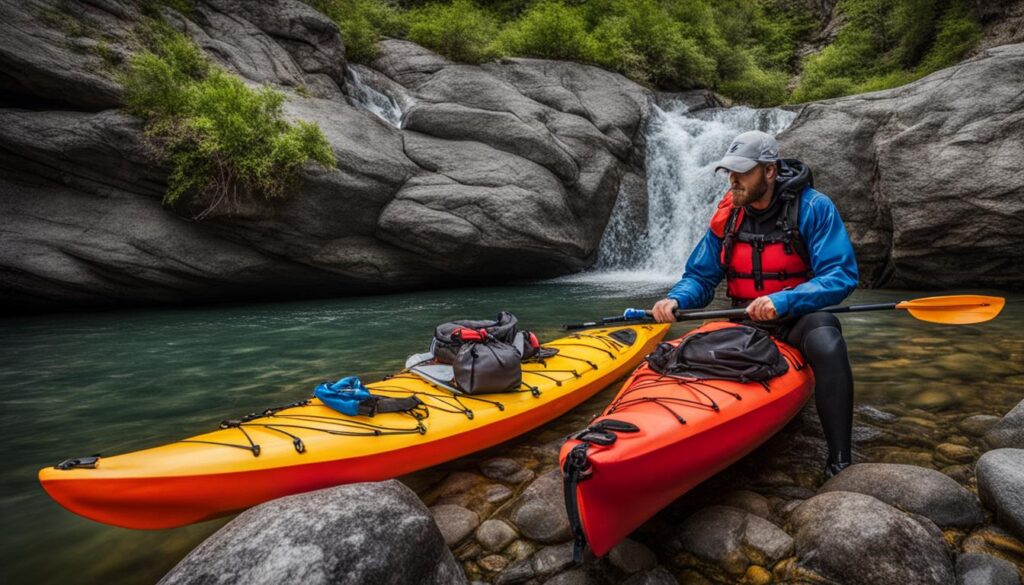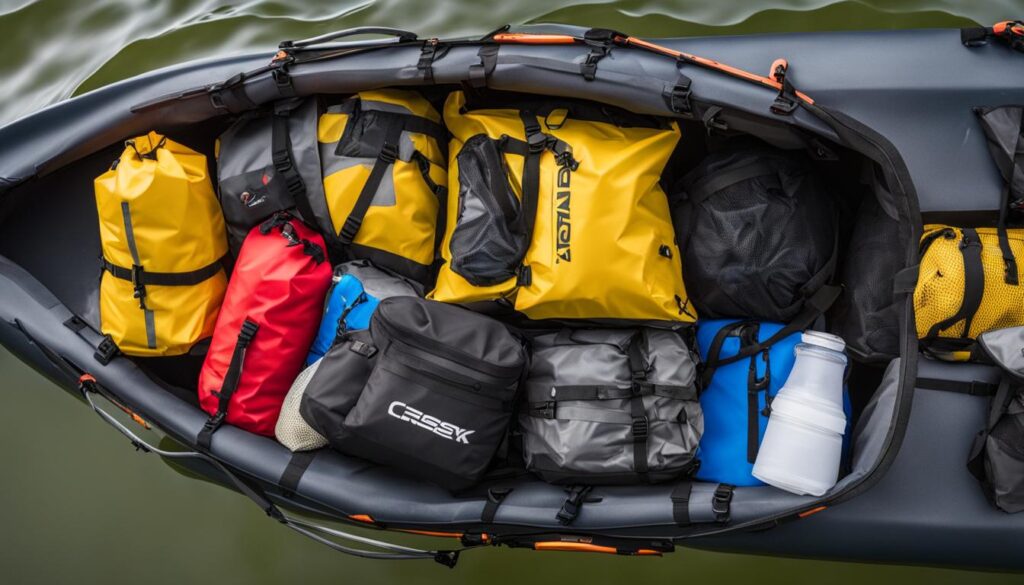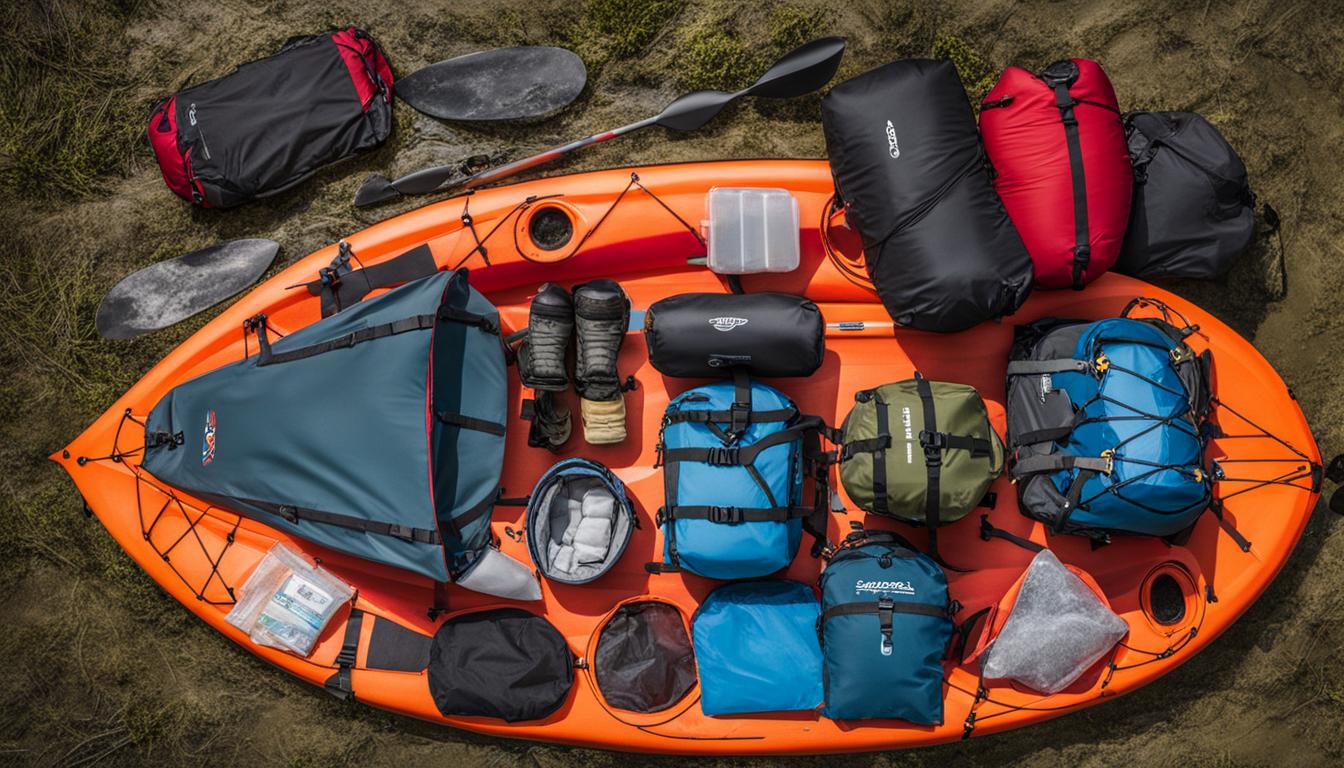Properly packing your kayak dry bag is essential for a stress-free and organized kayaking adventure. Follow these efficient kayak packing techniques to maximize space and ensure your gear stays dry. Choose the best dry bags for kayaking to suit your needs, whether you’re going on a day trip or an overnight excursion.
Key Takeaways:
- Efficient dry bag packing is crucial for a hassle-free kayaking experience.
- Maximize space in your dry bag by using efficient packing techniques.
- Choose the best dry bags for kayaking based on your specific needs.
- Proper organization and weight distribution optimize kayak stability and maneuverability.
- Prioritize safety by keeping essential items easily accessible in waterproof storage.
Choosing the Right Dry Bag and Organizing Gear
When it comes to packing your kayak dry bag, choosing the right bag and organizing your gear efficiently are key. One of the best options for keeping your belongings safe and dry is to use waterproof storage bags known as dry bags. These bags are available in various sizes and materials, such as vinyl, nylon, and sil-nylon, offering different levels of durability and waterproof protection.
To keep your gear well-organized, it’s important to group similar items together. Consider packing your clothing in one dry bag, your cooking equipment in another, and your electronics in a separate bag. This will make it easier to find what you need when you’re out on the water. Additionally, packing essential items that you may need throughout the day, like food and extra clothing, near the top of your load will ensure quick and easy access.
If you’re planning an overnight trip, compact packing techniques can help you maximize the space in your dry bag. Rolling your clothing instead of folding it can save space, and using compression sacks or packing cubes can help further condense your gear. Utilize every nook and cranny in your dry bag by filling gaps with smaller items like socks or toiletries.

Remember, the goal is to keep your gear dry and organized, so it’s important to invest in high-quality dry bags and take the time to arrange your items thoughtfully. By doing so, you’ll be able to enjoy your kayaking trips with peace of mind, knowing that everything you need is protected and easily accessible.
Tips for Proper Weight Distribution and Trim
When packing your kayak dry bag, it’s essential to consider proper weight distribution and trim. By arranging your gear strategically, you can maximize space in your kayak bags and ensure a balanced and efficient packing arrangement.
Maximizing Space in Kayak Bags
To make the most of your kayak bags’ space, start by placing heavier items towards the bottom and centerline of the boat. This will help lower the kayak’s center of gravity, improving stability and maneuverability. It’s also important to distribute weight evenly from side to side, ensuring a balanced load.
When packing your dry bags, roll clothing and other soft items tightly to minimize their size. You can also use compression sacks or vacuum-sealed bags to reduce bulk. Utilize every nook and cranny by filling empty spaces with smaller items or clothing.
Lightweight Packing for Kayaking
Keeping your gear lightweight is key to efficient kayak packing. Opt for lightweight camping equipment and clothing made from quick-drying materials. Look for compact versions of essential items, such as collapsible cookware and ultralight sleeping bags. Consider the weight and bulkiness of your dry bags as well. Choose lightweight materials like nylon or sil-nylon that won’t add unnecessary weight to your load.
Proper Trim for Improved Kayak Performance
Proper trim refers to the balance of weight from front to back in your kayak. A well-trimmed boat will sit flat in the water, allowing for smoother paddling and reducing the likelihood of veering off course. Pack heavier items towards the center of the kayak, closer to your seat. Avoid placing too much weight in the bow or stern, as this can negatively impact the kayak’s performance.

By following these tips for weight distribution and trim, you can create a well-balanced and efficient packing arrangement for your kayak dry bag. Maximizing space in your kayak bags and keeping your load lightweight will not only improve stability but also enhance your overall kayaking experience.
| Benefits of Proper Weight Distribution and Trim | Considerations |
|---|---|
| Improved stability and maneuverability | Place heavier items towards the bottom and centerline of the boat |
| Reduced risk of veering off course | Distribute weight evenly from side to side |
| Enhanced kayak performance | Use lightweight camping equipment and clothing |
| Optimized use of space in kayak bags | Roll clothing tightly and utilize compression sacks |
Safety Considerations and Special Placements
When packing your kayak dry bag, it’s essential to prioritize safety to ensure a smooth and secure paddling experience. By keeping a few key considerations in mind, you can pack your gear strategically and have important items easily accessible when needed. Here is a checklist of safety tips and special placements to include in your dry bag packing:
1. First-Aid Kit
Always carry a first-aid kit in your kayak and make sure it is easily accessible. Keep it under your seat or in a nearby storage compartment for quick and immediate access in case of any emergencies. Your first-aid kit should include essential items such as bandages, antiseptic wipes, adhesive tape, pain relievers, and any necessary personal medications.
2. Emergency Paddles
In case your primary paddle becomes damaged or lost, it’s important to have emergency paddles readily available. Secure them either flush against the gunwales or in the deck rigging of your kayak. This way, you’ll be prepared to continue paddling and maneuvering your kayak safely until you can retrieve or replace your primary paddle.
3. Signaling Devices
Carry signaling devices such as flares and whistles on your person at all times. These devices can be vital in alerting others to your presence or signaling for help in case of an emergency. Ensure they are easily accessible in your dry bag or attached to your personal flotation device (PFD) to ensure you can reach them quickly when needed.
4. Navigation Equipment
Keep your navigation equipment, such as maps and compasses, in waterproof cases to protect them from water damage. These items are crucial for ensuring you stay on course and navigate safely during your kayaking adventure. Store them in a secure and easily reachable pocket or compartment in your dry bag.
5. Handy Essentials
In addition to the safety items mentioned above, there are a few other essentials you should have within reach. Carry an adequate supply of water and snacks to stay hydrated and energized during your trip. Protect your eyes from the sun’s glare with sunglasses, and capture memorable moments with a waterproof camera. These items should be stored in a conveniently accessible pocket or compartment to ensure they are readily available when needed.
By following this safety checklist and strategically placing your essential items in your dry bag, you’ll be well-prepared for any situation that may arise during your kayaking adventure.
| Safety Considerations | Special Placements |
|---|---|
| First-Aid Kit | Under seat or nearby storage compartment |
| Emergency Paddles | Flush against gunwales or deck rigging |
| Signaling Devices | In easily accessible dry bag pocket or attached to PFD |
| Navigation Equipment | In waterproof cases, in a secure and reachable pocket or compartment |
| Handy Essentials | In a conveniently accessible pocket or compartment |
Conclusion
Efficiently packing your kayak dry bag is the key to hassle-free and enjoyable kayaking adventures. By choosing the right dry bag, organizing your gear effectively, distributing weight properly, and prioritizing safety considerations, you can maximize space, keep your gear dry, and have a smooth paddling experience.
When it comes to choosing the right dry bag, opt for waterproof storage bags that suit your needs. Consider the size and material of the dry bag, such as vinyl, nylon, or sil-nylon. Organize your gear by grouping similar items together, and pack essential items near the top for easy access. For longer trips, use compact and efficient packing techniques to make the most of the available space.
Proper weight distribution and trim are essential for stability and maneuverability. Pack the weight low and along the center line of your kayak to maintain proper trim. This will help your kayak lie flat in the water and reduce the risk of veering off course. Pay attention to weight distribution when arranging your dry bags in the kayak to ensure a balanced and efficient packing arrangement.
Prioritize safety by keeping a first-aid kit easily accessible and storing emergency paddles securely. Carry signaling devices and navigation equipment in waterproof cases. Keep important items like water, snacks, sunglasses, and cameras within reach. Consider using seat or thwart packs for small incidentals, keeping them organized and easily accessible.
Follow these tips and techniques to master efficient dry bag packing and embark on unforgettable kayak trips. With proper packing, you can enjoy your time on the water without unnecessary stress or worry about your gear. Get ready for a smooth paddling experience and create memories to last a lifetime!
FAQ
What are dry bags and why should I use them for kayaking?
Dry bags are waterproof storage bags that keep your gear dry during kayaking. They are essential to protect your belongings from water damage while enjoying your adventure.
What materials are dry bags made of?
Dry bags are commonly made of vinyl, nylon, or sil-nylon. Each material offers different levels of durability and waterproofing, so you can choose the one that suits your needs best.
How should I organize my gear in the dry bag?
Group similar items together, such as clothing, cooking equipment, and electronics. Pack essential items near the top for easy access. Utilize compact packing techniques to maximize space.
How should I distribute the weight in the kayak?
Pack the weight as low and along the center line of your kayak as possible. This helps maintain proper trim and improves stability and maneuverability.
What safety considerations should I keep in mind when packing my dry bag?
Keep a first-aid kit easily accessible, store emergency paddles securely, carry signaling devices on your person, and keep navigation equipment in waterproof cases. Organize and keep important items within reach.





